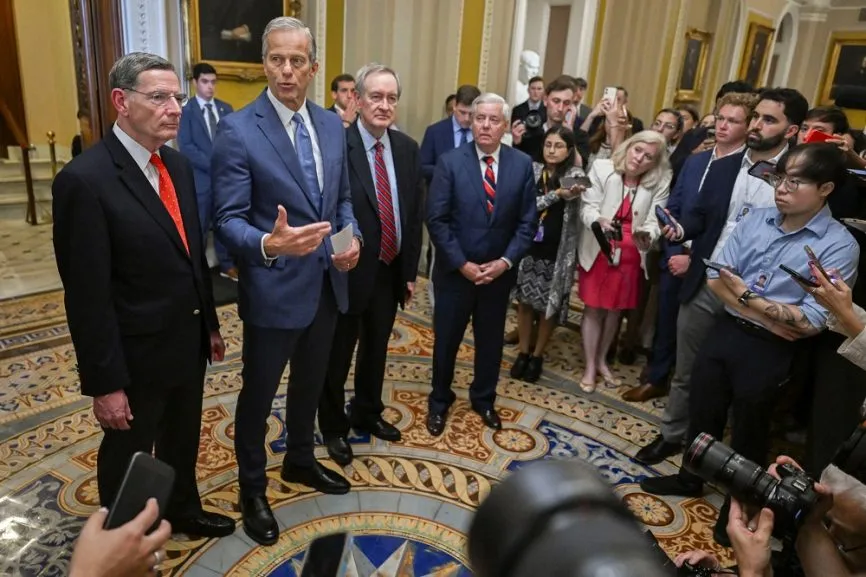In a dramatic late-night session, the U.S. Senate Republicans have narrowly passed President Donald Trump’s colossal tax-cut and spending bill, setting the stage for a contentious final battle in the House of Representatives. The legislation, a cornerstone of the Trump administration’s economic agenda, aims to slash taxes, significantly reduce social safety net programs, and boost spending on military and immigration enforcement, all while projected to add a staggering $3.3 trillion to the national debt.
The bill’s passage in the Senate, by a razor-thin 51-50 vote with Vice President JD Vance casting the tie-breaking vote, underscores the deep divisions within Congress and the nation over fiscal policy and government priorities. As the legislation now heads to the House for potential final approval, a handful of Republican dissenters there have already voiced strong opposition to some of its provisions, threatening President Trump’s ambition to sign it into law by the symbolic July 4 Independence Day holiday.
The Bill’s Core: Extending Tax Cuts and Reshaping Spending
At its heart, this legislation is designed to extend the bulk of the Tax Cuts and Jobs Act (TCJA) of 2017, a signature achievement of the previous Trump administration. The TCJA, enacted in December 2017, significantly lowered the corporate tax rate from 35% to a flat 21% and reduced individual income tax rates across most brackets. It also nearly doubled the standard deduction, increased the child tax credit, and introduced a controversial $10,000 cap on the State and Local Tax (SALT) deduction, which disproportionately affected taxpayers in high-tax states.
While the 2017 tax cuts were initially projected to add an estimated $1 trillion to $2 trillion to the federal debt over a decade, extending most of these provisions without corresponding offsets is now projected to have a far more substantial impact. The nonpartisan Congressional Budget Office (CBO) estimates that extending the expiring provisions of the 2017 tax cuts alone would decrease federal tax revenue by $4.5 trillion from 2025 through 2034. When combined with other elements of the current bill, the CBO forecasts that the Senate version will add $800 billion more to the national debt than the House version, pushing the total projected debt increase from this legislation to $3.3 trillion.
Beyond the extension of existing tax cuts, the bill introduces new tax breaks, notably for income derived from tips and overtime pay. These provisions aim to provide direct financial relief to a broad segment of the workforce, particularly those in service industries.
However, these tax cuts are coupled with significant shifts in federal spending:
- Increased Spending: The legislation allocates substantial additional funds to the military and immigration enforcement. The push for increased military spending reflects a continued focus on national security and defense capabilities, while boosted immigration enforcement funding signals a renewed emphasis on border control and internal enforcement measures, aligning with core tenets of the Trump administration’s agenda.
- Deep Cuts to Social Safety Net Programs: This is arguably the most contentious aspect of the bill. It proposes to cut approximately $930 billion from the Medicaid health program and food aid for low-income Americans.
- Medicaid: As a joint federal-state program, Medicaid provides vital healthcare services to over 96 million low-income Americans, including children, pregnant women, parents, the elderly, and individuals with disabilities. It is also the nation’s largest payer for long-term care services. The proposed cuts are expected to have a devastating impact, with the CBO forecasting that nearly 12 million more people would become uninsured under the Senate plan. Rural hospitals, which often serve a disproportionately high number of Medicaid patients and operate on thin margins, are particularly vulnerable. The American Hospital Association (AHA) has warned that such cuts could cause “irreparable harm to our health care system,” especially in rural areas where access to care is already limited.
- Food Aid: Cuts to food assistance programs, such as the Supplemental Nutrition Assistance Program (SNAP), would directly impact the ability of millions of low-income families to afford nutritious food. Critics argue this would “take the food out of the mouths of hungry kids,” increasing food insecurity across the nation.
- Repeal of Green-Energy Incentives: The bill also seeks to repeal many of former President Joe Biden’s green-energy incentives. These incentives, largely enacted through the Inflation Reduction Act, aimed to accelerate the transition to clean energy, promote electric vehicle adoption, and invest in renewable energy technologies. Their repeal would likely slow the growth of the clean energy sector, potentially jeopardizing green jobs and hindering efforts to combat climate change.
The Looming Shadow of National Debt
The legislation’s projected impact on the national debt has ignited fierce debate. The U.S. national debt currently stands at over $36.2 trillion, a figure that has grown significantly over the past decades. The bill’s addition of $3.3 trillion to this sum, coupled with a proposal to raise the federal government’s self-imposed debt ceiling by $5 trillion, highlights a growing fiscal challenge.
The debt ceiling is a legislative limit on the amount of national debt that the U.S. Treasury can incur. Historically, Congress has raised or suspended this limit to allow the government to pay its existing obligations. Failure to raise the debt ceiling would lead to a catastrophic default on U.S. debt, potentially triggering a global financial crisis, disrupting government operations, and damaging the nation’s creditworthiness. The CBO, a nonpartisan agency, plays a crucial role in providing independent analyses of the budgetary and economic effects of legislation. Its estimates, though often challenged by political factions, provide a baseline for understanding the long-term fiscal implications of bills like this.
Critics argue that increasing the national debt to finance tax cuts that primarily benefit the wealthy constitutes a “wealth transfer from younger to older Americans,” burdening future generations with the costs of current fiscal decisions.
The Political Gauntlet: From Senate Drama to House Hurdles
The Senate vote was a testament to the intense political maneuvering and ideological divides within the Republican Party.
Senate Showdown: A Tie-Breaking Vote and Key Concessions
The 51-50 vote saw Vice President JD Vance step in to break the tie, a constitutional duty for the Vice President as President of the Senate. This narrow victory came after an all-night debate filled with intense negotiations and “horse-trading” aimed at securing every necessary Republican vote.
Three Republican senators notably broke ranks and voted against the bill alongside all 47 Democrats:
- Senator Thom Tillis of North Carolina
- Senator Susan Collins of Maine
- Senator Rand Paul of Kentucky
Their opposition stemmed from a mix of concerns, including the bill’s impact on the national debt, its provisions regarding healthcare, and broader fiscal responsibility.
A pivotal figure in the late-stage negotiations was Senator Lisa Murkowski of Alaska. She had signaled her intent to vote against the bill without significant alterations, forcing Republican leadership to make concessions. The final Senate bill included two crucial provisions that helped secure her vote:
- Additional food-aid funding directed specifically to Alaska and several other states.
- A provision allocating $50 billion to help rural hospitals cope with the sweeping cuts to Medicaid, acknowledging the severe impact these cuts would have on healthcare access in underserved areas. These additions highlight the complex process of legislative compromise, where individual senators can leverage their votes to secure benefits for their constituents.
The House Battle: A Fraught Path to Final Approval
The legislation now faces an equally challenging path in the House of Representatives, where Republicans hold a slim 220-212 majority. House Speaker Mike Johnson has expressed his determination to meet President Trump’s July 4 deadline, aiming to move the legislation through the Rules Committee and bring it to a full House vote by Thursday or Friday, contingent on weather conditions in Washington.
However, internal Republican opposition poses a significant hurdle:
- House Freedom Caucus: This group of hardline conservatives has been a vocal critic of the bill’s price tag, demanding deeper spending cuts to offset the tax reductions and reduce the deficit impact. Representative Chip Roy, a prominent member of the Freedom Caucus, stated that “there’s a significant number who are concerned” about the Senate version’s cost, which the CBO estimates adds $800 billion more to the national debt than the House’s initial proposal. Their historical willingness to withhold support for key legislation makes their opposition a serious threat.
- Moderate Republicans: A separate group of more moderate House Republicans, particularly those representing lower-income areas, have expressed strong objections to the steeper Medicaid cuts in the Senate’s plan. They fear the adverse effects on their constituents, including potential service cutbacks in rural areas, which could lead to political backlash.
- High-Tax State Republicans: A handful of Republicans from states with high state and local taxes, such as New York, New Jersey, and California, continue to demand a larger tax break for state and local tax (SALT) payments. The $10,000 SALT cap introduced by the 2017 TCJA has been a persistent point of contention for these lawmakers, who argue it unfairly burdens their constituents.
House Democrats are expected to remain unanimously opposed to the bill. House Democratic Leader Hakeem Jeffries has vehemently condemned the legislation, calling it the “largest assault on American healthcare in history” and the “largest assault on nutrition in American history.” Their unified front will make every Republican vote critical for the bill’s passage.
The White House has indicated that President Trump will be “deeply involved” in lobbying House Republicans to approve the bill, with Trump himself proclaiming it a “great bill” with “something for everyone.” However, the internal divisions within the Republican caucus suggest that securing final passage will require intense pressure and potentially further concessions.
Economic and Social Implications: A Divided Future
The passage of this bill would have profound and far-reaching economic and social implications for the United States.
- Exacerbating Inequality: Independent analyses, including those from the Tax Foundation, consistently show that the bill’s primary beneficiaries would be the top 1% of U.S. households, those earning $663,000 or more in 2025. These high earners would gain the most from the tax cuts, further widening the gap between the wealthiest Americans and the rest of the population. The increased national debt, financed by future generations, effectively serves as a wealth transfer from younger to older Americans, exacerbating intergenerational inequality.
- Healthcare Access Crisis: The proposed Medicaid cuts and the CBO’s forecast of 12 million more uninsured individuals would represent a significant rollback of healthcare access for vulnerable populations. This could lead to increased emergency room visits, delayed treatments, and a greater burden on uncompensated care, straining the healthcare system, particularly in rural and underserved communities.
- Food Insecurity: Reductions in food aid programs would directly impact the most vulnerable segments of society, increasing rates of hunger and malnutrition, especially among children and the elderly.
- Environmental Policy Reversal: The repeal of green-energy incentives would signal a significant shift away from climate action, potentially undermining efforts to reduce carbon emissions and transition to a cleaner economy. This could also place the U.S. at a disadvantage in the global race for green technologies and industries.
The Ideological Divide and Future Outlook
Republicans have defended the Medicaid cuts by arguing they would primarily “root out waste, fraud, and abuse” from the system, suggesting that the program is inefficiently managed. However, Democrats and healthcare advocates counter that such broad cuts would inevitably harm legitimate beneficiaries and essential services.
The criticism extends beyond traditional political lines. Billionaire Elon Musk, a former Trump ally who has historically donated to both Democrats and Republicans but has recently shifted his political contributions almost entirely to right-wing candidates, has publicly railed against the bill’s “enormous cost.” Musk has even vowed to back challengers to Republican lawmakers in next year’s midterm elections if they support the bill, indicating a growing concern about fiscal responsibility even among some conservative-leaning figures.
The national debt, currently exceeding $36 trillion, has become a central battleground in American politics. If the expiring tax cuts are made permanent without significant spending offsets, CBO projections indicate the debt-to-GDP ratio could reach 214% by 2054, a level some economists deem “unsustainable” and a potential trigger for a severe financial crisis.
The passage of this bill is not merely a legislative victory; it is a profound statement about the Republican Party’s economic philosophy and its priorities for the nation’s future. For President Trump, it represents a crucial legislative achievement ahead of upcoming elections, allowing him to deliver on key campaign promises related to tax cuts and spending. However, the fierce opposition and internal party divisions suggest that the political fallout from this bill, regardless of its final outcome, will continue to shape the American political landscape for years to come.
Conclusion: A Defining Moment for the American Economy
The U.S. Senate’s passage of President Trump’s sweeping tax-cut and spending bill marks a defining moment for American fiscal policy. It embodies a clear ideological choice: prioritizing broad tax reductions and increased spending in select areas, even at the cost of a rapidly expanding national debt and significant cuts to social safety net programs.
The battle now moves to the House of Representatives, where the bill faces a challenging path through a narrowly divided chamber. The internal Republican dissent, coupled with unified Democratic opposition, ensures that the debate will be intense and the outcome uncertain.
Regardless of whether the bill ultimately becomes law, its journey through Congress has laid bare the deep fissures within American politics concerning economic priorities, social responsibility, and the nation’s long-term fiscal health. The implications for healthcare, food security, environmental policy, and wealth distribution are profound, promising to shape public discourse and political campaigns for the foreseeable future. As the July 4 deadline looms, all eyes remain on Capitol Hill, awaiting the final chapter of this high-stakes legislative drama.
Ready to take your career to the next level? Join our dynamic courses: ACCA, HESI A2, ATI TEAS 7 , HESI EXIT , NCLEX – RN and NCLEX – PN, Financial Literacy!🌟 Dive into a world of opportunities and empower yourself for success. Explore more at Serrari Ed and start your exciting journey today! ✨
photo source: Google
By: Montel Kamau
Serrari Financial Analyst
3rd July, 2025
Article, Financial and News Disclaimer
The Value of a Financial Advisor
While this article offers valuable insights, it is essential to recognize that personal finance can be highly complex and unique to each individual. A financial advisor provides professional expertise and personalized guidance to help you make well-informed decisions tailored to your specific circumstances and goals.
Beyond offering knowledge, a financial advisor serves as a trusted partner to help you stay disciplined, avoid common pitfalls, and remain focused on your long-term objectives. Their perspective and experience can complement your own efforts, enhancing your financial well-being and ensuring a more confident approach to managing your finances.
Disclaimer: This article is for informational purposes only and does not constitute financial advice. Readers are encouraged to consult a licensed financial advisor to obtain guidance specific to their financial situation.
Article and News Disclaimer
The information provided on www.serrarigroup.com is for general informational purposes only. While we strive to keep the information up to date and accurate, we make no representations or warranties of any kind, express or implied, about the completeness, accuracy, reliability, suitability, or availability with respect to the website or the information, products, services, or related graphics contained on the website for any purpose. Any reliance you place on such information is therefore strictly at your own risk.
www.serrarigroup.com is not responsible for any errors or omissions, or for the results obtained from the use of this information. All information on the website is provided on an as-is basis, with no guarantee of completeness, accuracy, timeliness, or of the results obtained from the use of this information, and without warranty of any kind, express or implied, including but not limited to warranties of performance, merchantability, and fitness for a particular purpose.
In no event will www.serrarigroup.com be liable to you or anyone else for any decision made or action taken in reliance on the information provided on the website or for any consequential, special, or similar damages, even if advised of the possibility of such damages.
The articles, news, and information presented on www.serrarigroup.com reflect the opinions of the respective authors and contributors and do not necessarily represent the views of the website or its management. Any views or opinions expressed are solely those of the individual authors and do not represent the website's views or opinions as a whole.
The content on www.serrarigroup.com may include links to external websites, which are provided for convenience and informational purposes only. We have no control over the nature, content, and availability of those sites. The inclusion of any links does not necessarily imply a recommendation or endorsement of the views expressed within them.
Every effort is made to keep the website up and running smoothly. However, www.serrarigroup.com takes no responsibility for, and will not be liable for, the website being temporarily unavailable due to technical issues beyond our control.
Please note that laws, regulations, and information can change rapidly, and we advise you to conduct further research and seek professional advice when necessary.
By using www.serrarigroup.com, you agree to this disclaimer and its terms. If you do not agree with this disclaimer, please do not use the website.
www.serrarigroup.com, reserves the right to update, modify, or remove any part of this disclaimer without prior notice. It is your responsibility to review this disclaimer periodically for changes.
Serrari Group 2025












